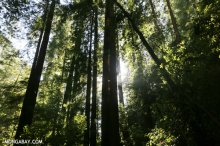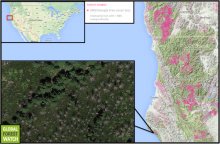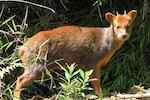Temperate Rainforest Environmental Issues
 Redwoods in Big Basin State Park, California. Photo by Rhett A. Butler.
Redwoods in Big Basin State Park, California. Photo by Rhett A. Butler.
If you Google “rainforest, ” you’re almost assured to get a page of search results mostly about the tropics. Yet, another kind of rainforest also exists: temperate rainforests. Far less expansive than the tropical kind, temperate rainforests occur in isolated patches and strips around the world – from the coasts of western North America and eastern Siberia, to throughout much of New Zealand and Tasmania. In a new study published recently in Earth Systems and Environmental Sciences, researchers warn that temperate rainforests may be in for big changes in the face of global warming, and they recommend reducing greenhouse gas emissions before it’s too late.
Definitions vary per country as to what exactly defines a temperate rainforest, but generally, they comprise dense stands of forest with canopies covering most of the sky, occur in areas with high annual rates of rainfall, and are composed mainly of tree species that don’t need fire to reproduce. They are a highly biodiverse biome, supporting many different species – including many endemics. Research indicates 45 percent of the vertebrates in Chile’s temperate rainforests, for example, are found nowhere else on earth.
They are a highly biodiverse biome, supporting many different species – including many endemics. Research indicates 45 percent of the vertebrates in Chile’s temperate rainforests, for example, are found nowhere else on earth.
Human impacts have long affected temperate rainforests. Most of Europe’s were logged long ago, Chile’s declined significantly in the last century, and few redwoods remain on the U.S. west coast compared to the extensive forests that existed before Europeans entered the scene. Now, after logging pressures have somewhat subsided and protected areas have been established to preserve the remnants that remained, the world’s temperate rainforests are facing a new threat: global warming.
Atmospheric greenhouse gas levels are ramping up as fossil fuels are burned, trees are cut down, and methane leaches from the sea, the arctic, cows, and palm oil production plants (among many other sources). Carbon dioxide, the primary culprit, now hovers at 400 parts per million (ppm), a level not recorded at any other point in human history. These high levels of greenhouse gases are trapping heat energy in the atmosphere, which, in turn, is changing climates around the world.
Carbon dioxide, the primary culprit, now hovers at 400 parts per million (ppm), a level not recorded at any other point in human history. These high levels of greenhouse gases are trapping heat energy in the atmosphere, which, in turn, is changing climates around the world.
The authors of the study used global climate models to predict what will happen to temperature and precipitation patterns along a 2, 200-mile stretch of coastline in western North America if greenhouse gases continue to rise. They found coast redwoods may lose 23 percent of their current distribution, the range of Alaska yellow-cedar could shrink 21 percent, and rainforest communities in Oregon and northern California may contract. They also found most of the protected areas in the study region will not be immune from climatic changes.
Global Forest Watch shows extensive forest loss in the coastal forests of northern California and southern Oregon. Satellite imagery shows significant tree die-off in King’s Range National Conservation Area. In total, the conservation area lost more than 13 percent of its tree cover from 2001 through 2012.











